Heteroonops (Araneae, Oonopidae) spiders from Hispaniola: the discovery of ten new species
- PMID: 32939145
- PMCID: PMC7471135
- DOI: 10.3897/zookeys.964.51554
Heteroonops (Araneae, Oonopidae) spiders from Hispaniola: the discovery of ten new species
Abstract
The Caribbean biodiversity hotspot harbors vast reserves of undiscovered species. A large-scale inventory of Caribbean arachnids (CarBio) is uncovering new species across the arachnid tree of life, and allowing inference of the evolutionary history that has generated this diversity. Herein we describe ten new species of Heteroonops (Oonopidae, or goblin spiders), from Hispaniola: H. scapula sp. nov., H. jurassicus sp. nov., H. aylinalegreae sp. nov., H. verruca sp. nov., H. renebarbai sp. nov., H. yuma sp. nov., H. carlosviquezi sp. nov., H. gabrielsantosi sp. nov., H. solanllycarreroae sp. nov. and H. constanza sp. nov. The occurrence of the pantropical type species Heteroonops spinimanus (Simon, 1891) is reported and new localities are given for: H. validus (Bryant, 1948), H. vega (Platnick & Dupérré, 2009) and H. castelloides (Platnick & Dupérré, 2009). Molecular phylogenies indicate substantial genetic divergence separating these taxa. This work adds to evidence that the depth of diversity in the Caribbean biodiversity hotspot is particularly striking for tiny taxa living in leaf litter.
Keywords: Caribbean biogeography; Goblin spiders; biodiversity hotspot; molecular phylogeny.
Nadine Dupérré, Charlotte Francisco, Ella Santana-Propper, Ingi Agnarsson, Greta J. Binford.
Figures

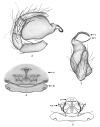
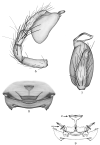
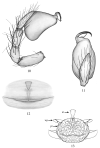
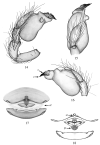




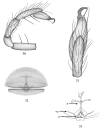


Similar articles
-
A new species of the Goblin Spider genus Predatoroonops/ Brescovit, Rheims amp; Ott 2012 (Araneae, Dysderoidea: Oonopidae), with new records for the genus.Zootaxa. 2021 Apr 22;4964(2):zootaxa.4964.2.11. doi: 10.11646/zootaxa.4964.2.11. Zootaxa. 2021. PMID: 33903525
-
The goblin spider genus Ischnothyreus (Araneae, Oonopidae) in Java and Sumatra.Zootaxa. 2016 Aug 17;4151(1):1-99. doi: 10.11646/zootaxa.4151.1.1. Zootaxa. 2016. PMID: 27615819
-
Revision of goblin spiders (Araneae: Oonopidae) in the Nansei Islands, Southwest Japan, with description of a new species.Zootaxa. 2023 Aug 1;5323(2):216-242. doi: 10.11646/zootaxa.5323.2.3. Zootaxa. 2023. PMID: 38220970
-
Amazoonops, a new genus of goblin spiders (Araneae: Oonopidae) from the Brazilian Amazon.Zootaxa. 2017 Feb 22;4236(2):zootaxa.4236.2.2. doi: 10.11646/zootaxa.4236.2.2. Zootaxa. 2017. PMID: 28264324
-
The new Southeast Asian goblin spider genus Aposphragisma (Araneae, Oonopidae): diversity and phylogeny.Zootaxa. 2014 May 22;(3798):1-86. doi: 10.11646/zootaxa.3798.1.1. Zootaxa. 2014. PMID: 24870867
Cited by
-
A new genus and two new species of oonopid spiders from Tibet, China (Araneae, Oonopidae).Zookeys. 2021 Jul 30;1052:55-69. doi: 10.3897/zookeys.1052.66402. eCollection 2021. Zookeys. 2021. PMID: 34393552 Free PMC article.
References
-
- Abrahim N, Brescovit AD, Rheims CR, Santos AJ, Ott R, Bonaldo AB. (2012) A revision of the Neotropical goblin spider genus Neoxyphinus Birabén, 1953 (Araneae, Oonopidae). American Museum Novitates 3743: 1–75. 10.1206/3743.2 - DOI
-
- Agnarsson I, Van Patten C, Sargeant L, Chomitz B, Dziki A, Binford G. (2018) A radiation of the ornate Caribbean ‘smiley-faced spiders’ – with descriptions of 15 new species (Araneae, Theridiidae, Spintharus). Zoological Journal of the Linnean Society 182: 758–790. 10.1093/zoolinnean/zlx056 - DOI
-
- Baehr BC, Ubick D. (2010) A review of the Asian goblin spider genus Camptoscaphiella (Araneae: Oonopidae). American Museum Novitates 3697: 1–65. 10.1206/3697.2 - DOI
-
- Benoit PLG. (1964) La découverte d’Oonopidae anophthalmes dans des termitières africaines (Araneae). Revue de Zoologie et de Botanique Africaines 70: 174–187.
LinkOut - more resources
Full Text Sources
